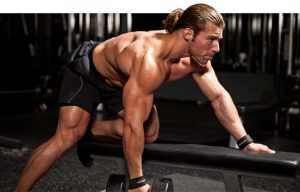Weight training – Train movements, not muscles
 When it comes to weight training in the gym, it is common for people to break up there routine into the different muscles they are training that day – e.g. Back, chest, legs, shoulders and arms.
When it comes to weight training in the gym, it is common for people to break up there routine into the different muscles they are training that day – e.g. Back, chest, legs, shoulders and arms.
The way the body functions optimally is by recruiting a series of muscles to perform a specific movement, not singular muscles in isolation. For example, many people train an isolated biceps curl using the preacher curl bench. Can you think of any sports or physical activities where this isolated movement is replicated? An alternative exercise which will help strengthen the biceps in the close grip pull up (palms inward). In addition to training the biceps the pull up will engage the latissimus dorsi, the middle and lower portion of the trapezius, the rhomboids, the abdominal muscle group and many more. And because it is movement focused instead of specific muscle focused it becomes more functional. If you were in a burning building would you want the fireman with the chiseled guns, or the fireman who can repeatedly his pull up own body weight to climb up and rescue you?
So is there a place for isolated muscle training. The answer is yes. If there is a significant deficit in strength due to injury, poor posture, poor movement quality, or muscle inhibition due to pain and inflammation then certainly muscles should be trained in isolation, until they are performing at a satisfactory level. The key to effective movement after such an injury, is to progress, beginning by training the muscle in isolation and then learning how to integrate the previously deficient muscle into functional movement patterns.
To apply this in the gym, think about the possible movements the body can perform, and train the compound exercises that replicate those movements. For example for upper body you can push or pull, in a horizontal or vertical plane (and anywhere in between). This can be then broken down into a day performing upper body “push” movements – bench press, shoulder press, incline dumbbell press etc, or upper body “pull” movements – pull ups, bent over rows, lat pull down etc. These movements are compound, they use multiple joints and many muscles to perform.
When you train muscles, your brain can forget movements, but when you train movements, you won’t forget muscles.
